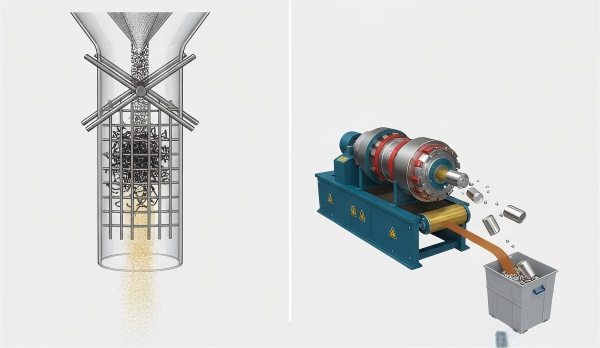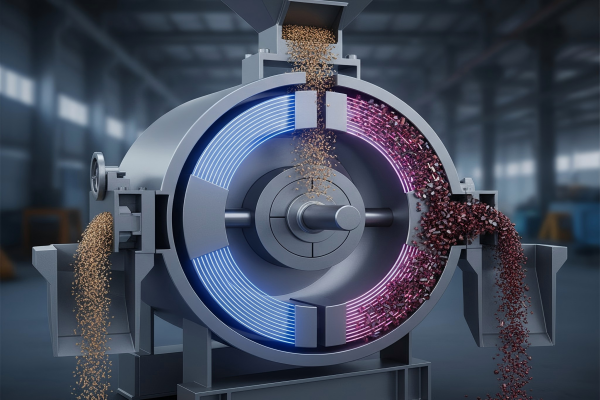A magnet can be used to separate mixtures by attracting and removing materials that contain iron, nickel, or cobalt. When a mixture contains both magnetic and non-magnetic substances, placing a magnet near it will pull the magnetic particles away, leaving the rest behind.
This method is simple, clean, and efficient, which is why it is widely used in laboratories, recycling facilities, food processing plants, and industrial manufacturing.
Whether the goal is to remove metal contaminants or to extract valuable magnetic minerals, magnetic separation provides a reliable and cost-effective solution.
This guide serves as the complete resource for anyone wanting to use magnets to separate mixtures. We’ve organized it to provide direct value to our diverse readers. You’ll find the information you need quickly.
- For Industrial Engineers & Purchasing Managers: Go to our sections on [Choosing the Right Magnetic Equipment](#a-guide-to-equipment) and [Industrial Applications](#key-industries) for practical advice on selecting separators for your processing line.
- For Students & Educators: The sections on [Fundamental Principles](#the-fundamental-principle) and [Simple Separation Experiments](#separation-in-action) offer clear explanations and hands-on classroom activities.
- For Lab Researchers & Scientists: You’ll find detailed information in [Magnetic Principles](#the-fundamental-principle) and the comparison of [Magnet Materials](#choosing-your-magnet-material) for your experimental setup.
Table of Contents
The Fundamental Principle
To understand how magnetic separation works, we need to examine how materials behave around magnetic fields. Not all materials react the same way.
The success of magnetic separation depends entirely on magnetic susceptibility. This property determines everything.
Attraction and Susceptibility
Magnetic susceptibility measures how much a material becomes magnetized in a magnetic field. It determines whether a material attracts to, repels from, or ignores a magnet.
Think of it as a popularity contest. Ferromagnetic materials are “very popular” with magnets and attract strongly. Other materials either don’t care or even repel slightly. This difference in reaction makes the entire process work.
Three Classes of Materials
Every material falls into one of three magnetic categories. Understanding these categories helps determine if a magnet can separate your specific mixture.
Most magnetic separation applications aim to isolate strongly magnetic materials from weakly magnetic or non-magnetic ones.
Material Type | Reaction to Magnetic Field | Common Examples | Separation Feasibility |
Ferromagnetic | Strongly Attracted | Iron, Nickel, Cobalt, Steel, some rare-earth alloys | Excellent. These are the primary targets for magnetic separation. |
Paramagnetic | Weakly Attracted | Aluminum, Platinum, Manganese, Oxygen | Possible, but requires extremely powerful magnetic fields (often used in specialized lab/industrial settings). |
Diamagnetic | Weakly Repelled | Copper, Gold, Water, Wood, Most Plastics | Not feasible with standard magnetic separation techniques. |
For most practical purposes, from classroom to factory, we separate ferromagnetic materials from non-magnetic streams. These streams contain diamagnetic and paramagnetic materials. The strong attraction of ferromagnetic materials makes this separation efficient and reliable.
Separation in Action

The theory of magnetic susceptibility comes alive in real-world scenarios. The same principle works from simple tabletop experiments to multi-ton-per-hour industrial operations.
Here, we’ll show the magnetic separation process at two different scales. This demonstrates its versatility.
An At-Home Experiment
This simple experiment perfectly shows the magnetic separation process. It’s popular in classrooms and excellent for anyone new to the concept.
Materials Needed:
- A shallow tray or plate
- Fine, dry sand
- Iron filings or small steel paper clips
- A strong magnet (a bar magnet or neodymium disc works well)
- A thin plastic bag or plastic wrap
Step-by-Step Instructions:
- First, create your mixture. Pour sand into the shallow tray. Mix in the iron filings thoroughly. Make sure they’re well-distributed.
- Next, prepare your tool. Wrap the magnet in the plastic bag. This is crucial: it prevents iron filings from sticking directly to the magnet. This makes cleanup instant and easy.
- Begin the separation. Hold the wrapped magnet just above the sand and iron mixture. Slowly drag it through the tray.
- You’ll immediately see iron filings “jump” from the sand and stick to the plastic-wrapped magnet. The sand stays behind.
- To collect the iron, move the magnet away from the tray. Hold it over a separate, empty container. Simply pull the magnet out of the bag. The iron filings will fall cleanly into the container without the magnetic force.
- Observe your results. You’ve successfully used a magnet to separate a mixture. This demonstrates the core principle of what is magnetic separation.
Industrial Case Study: Mining
Now let’s scale up dramatically. In large iron ore mines, the goal is separating valuable iron-bearing minerals like magnetite from worthless non-magnetic rock and soil called gangue.
This process isn’t just for purification. It makes mining economically viable.
The Process Flow:
- Crushing & Grinding: The journey starts at the crusher. Raw ore, possibly large boulders, gets crushed and ground into fine powder. This step “liberates” individual magnetite particles from surrounding gangue.
- Slurry Creation: This fine powder mixes with water to create slurry. Slurry behaves like liquid, making it easy to pump and transport through the processing plant.
- The Magnetic Drum Separator: The slurry feeds to the operation’s workhorse: a magnetic drum separator. This is a large, rotating stainless steel drum. A powerful, stationary magnet assembly sits inside, covering about half the drum’s arc.
- As slurry flows onto the rotating drum, magnetic magnetite particles get captured and held to the drum’s surface. The drum’s rotation carries them upward.
- Meanwhile, non-magnetic gangue isn’t affected by the magnetic field. It washes off the drum and discharges as waste or tailings.
- Collection: As the drum continues rotating, captured magnetite particles move past the stationary internal magnet’s end. They instantly lose their magnetic hold and discharge into a separate chute as high-grade concentrate.
- Dewatering: Finally, this purified magnetite concentrate, still in slurry form, gets dewatered to remove excess water. The result is high-grade iron product ready for the next stage: forming into pellets and sending to steel mills.
This magnetic separation process can increase iron content from as low as 20-30% in raw ore to over 65% in final concentrate. This transformation is fundamental to the global steel industry. For more data on mineral commodities, the U.S. Geological Survey (USGS) Minerals Yearbook is an authoritative resource.
A Guide to Equipment

For industrial and research applications, choosing the right magnetic tool is critical. The decision involves selecting both the raw magnet material and the engineered equipment that houses it.
This section guides engineers, lab managers, and procurement specialists.
Choosing Your Magnet Material
The heart of any separator is the magnet itself. Choosing the magnet alloy is the first critical decision. It determines the system’s strength, temperature resistance, corrosion tolerance, and overall cost.
Each magnet type has a distinct profile. This makes it suitable for specific tasks.
Magnet Type | Magnetic Strength (BHmax) | Max Operating Temp. | Corrosion Resistance | Cost | Best For… |
Neodymium (NdFeB) | Very High (30-55 MGOe) | Low (~80-200°C) | Poor (requires coating) | Medium-High | Applications needing maximum strength in a small size at room temperature. |
Ferrite (Ceramic) | Low (3-5 MGOe) | High (~250°C) | Excellent | Low | Cost-sensitive, high-volume applications where extreme strength isn’t needed (e.g., conveyor pulleys). |
Samarium Cobalt (SmCo) | High (18-32 MGOe) | Very High (~300-350°C) | Good | High | High-performance, high-temperature applications (aerospace, military, demanding industrial). |
Alnico | Medium (5-9 MGOe) | Very High (~500°C) | Excellent | High | Specialized high-temp applications, sensors, scientific instruments. |
Neodymium magnets are often the default choice for high-intensity separation due to their incredible strength-to-size ratio. However, environmental factors like heat can require other materials.
Types of Industrial Separators
Raw magnets are rarely used alone in factory settings. They integrate into carefully engineered systems designed for specific process flows and materials.
Here are some of the most common types of industrial magnetic separators.
Magnetic Rods and Grates
These are the simplest and most versatile industrial separators. They consist of powerful, tube-encased magnets, typically neodymium, arranged in grids or as single bars.
They’re placed directly into product flow within hoppers, chutes, or pipes. As material flows over and around the tubes, any ferrous metal gets captured and held on the surface.
Their primary use is removing fine and small “tramp” ferrous contamination from dry or liquid products. This includes metal dust, rust particles, and stray nuts or bolts.
You’ll find them in industries like food processing (for sugar, flour, spices), plastics manufacturing, pharmaceuticals, and chemical processing. For high-purity applications in food or pharma, exploring a range of Magnetic Rods and Grates is the first step to ensuring product safety and quality.
Magnetic Pulleys and Drums
These are designed for continuous, automated separation in bulk material handling systems. A magnetic pulley replaces the standard head pulley of a conveyor belt.
As conveyed material reaches the belt’s end, the pulley holds magnetic items to the belt’s surface. They’re carried underneath and released into a separate chute. Non-magnetic material falls off normally. Magnetic drums work similarly, with material fed onto a rotating drum.
Their primary use is automatically separating larger ferrous materials from high-volume bulk solids. This protects downstream equipment like crushers and purifies the product stream.
Key industries include recycling, mining, aggregate, and bulk material handling. In heavy-duty environments like recycling and mining, robust Magnetic Drums and Pulleys are essential for protecting equipment and purifying product. Publications like Recycling Today often highlight the importance of efficient metal separation in these sectors.
Overband Separators
An overband, or cross-belt, separator is a heavy-duty system suspended over a conveyor. It consists of a large magnet block (either permanent or electromagnetic) with a cleated belt running around it.
As material passes underneath on the main conveyor, the powerful magnetic field reaches down and lifts ferrous metals up. The overband’s belt then carries these metals to the side and discharges them into a collection bin.
This equipment is used for high-volume separation where the contaminant load is heavy and material burden depth is deep.
It’s indispensable in scrap yards, municipal solid waste (MSW) facilities, and demolition sites. The Institute of Scrap Recycling Industries (ISRI) provides standards and best practices for many of these applications.
A Note on Non-Ferrous Metals
It’s crucial to understand that standard magnets don’t work on valuable non-ferrous metals like aluminum, copper, brass, and zinc. This is a common point of confusion.
For these materials, a more advanced technology called an Eddy Current Separator is required. It uses a high-speed rotating rotor of powerful magnets to induce electrical currents, or “eddy currents,” in non-ferrous metals. These currents create their own magnetic field that repels the metal, effectively “throwing” it forward and away from the rest of the material stream. This principle is well-explained on educational sites like HowStuffWorks.
How to Select a Separator
Choosing the right separator is a technical decision that impacts efficiency, safety, and profitability. It requires clear understanding of the application.
Answering these key questions will guide you toward the correct solution.
- What is your product? Is it dry powder, liquid, slurry, or bulk solid like wood chips or shredded plastic? The material’s form determines the equipment type.
- What are you trying to remove? Are you capturing fine ferrous dust (parts per million) or removing large tramp metal like wrenches and bolts? The size and nature of the contaminant determine required magnetic strength and design.
- What is the process flow? Is the material falling through a gravity-fed chute, moving along a conveyor belt, or being pumped through a pipeline? The separator must integrate seamlessly into your existing line.
- What are the operating conditions? Consider temperature, humidity, and whether the product is abrasive. These factors influence the choice of magnet material and housing construction.
- What are the regulatory requirements? Food, dairy, and pharmaceutical applications have strict sanitary design standards (e.g., HACCP, FDA). The equipment must be certified to meet these rules.
Answering these questions will guide you to a standard solution or indicate the need for a tailored approach. For complex challenges, consulting with experts on Custom Magnetic Solutions can ensure optimal performance and return on investment.
Key Industries
The application of what is magnetic separation is vast and spans nearly every industry that processes physical goods. It’s a silent workhorse ensuring purity, protecting machinery, and recovering value.
Here are some key industries that rely heavily on this technology.
- Mining & Mineral Processing: As detailed in our case study, magnetic separation is essential for concentrating ferromagnetic ores like magnetite and chromite. It also removes iron contamination from other minerals.
- Recycling: This technology is the backbone of the recycling industry. It’s used in scrap yards and material recovery facilities (MRFs) to efficiently separate valuable ferrous metals (steel and iron) from mixed streams of plastic, glass, paper, and aluminum.
- Food & Pharmaceutical: In these sectors, magnetic separation is a critical control point for product safety and purity. It removes any potential fine metal contamination that may have entered the product from processing equipment. This complies with standards like HACCP and GFSI. The FDA’s page on Food Safety outlines the stringent regulations that make such protection necessary.
- Chemical & Plastics: Magnetic separators purify final products. Just as importantly, they protect sensitive and expensive processing machinery like grinders, extruders, and molding machines from being destroyed by stray tramp metal.
- Aggregate, Cement & Ceramics: In these industries, removing iron contamination is vital. It improves the quality, color, and structural integrity of the final product. It also protects high-wear equipment like crushers and mills from catastrophic damage.
- Power Generation (Coal): Before coal is pulverized into fine powder for combustion, it passes under powerful magnetic separators. This removes any tramp iron from the coal, which could otherwise cause sparks in the pulverizer, leading to devastating explosions and equipment damage.
Summarize
From the simple act of a bar magnet lifting iron filings from sand to massive overband separators cleaning tons of material every hour, the answer to what is magnetic separation is clear. It’s a fundamental, versatile, and powerful force for purification.
The process is elegant in its simplicity yet profound in its industrial impact. It leverages a basic law of physics, engineered into sophisticated tools that serve a vast array of human needs.
By understanding the principles of magnetic attraction and knowing the available equipment, industries can protect their machinery. They can improve the quality and safety of their products and enhance their bottom line. It’s a testament to how a simple physical force can be harnessed to solve complex, real-world challenges across the globe.
We are a manufacturer specializing in the research and development of magnets with years of industry experience. Our product offerings include NdFeB magnets, ferrite magnets, and custom magnetic components. Our goal is to provide high-quality magnetic solutions to customers worldwide, and we also offer OEM/ODM customization services. If you have any questions about magnets or custom applications, please feel free to contact our team of experts.
Facebook
Twitter
LinkedIn
WhatsApp

